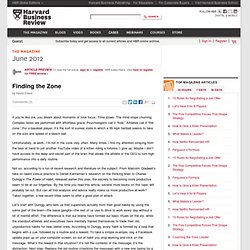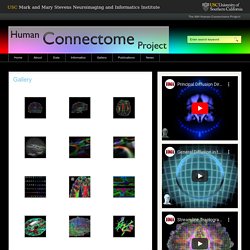

NeuroLeadership. Finding the Zone. If you’re like me, you dream about moments of total focus.

Time slows. The mind stops churning. Complex tasks are performed with effortless grace. Psychologists call it “flow.” Athletes call it “the zone.” Unfortunately, at work, I’m not in the zone very often. Not so, according to a ton of recent research and literature on the subject. “The brilliance of this system was that it removed the need for decision making. Charles Duhigg, The Power of Habit: Why We Do What We Do in Life and Business Let’s start with Duhigg, who tells us that superstars actually form their good habits by using the same part of the brain—the basal ganglia—the rest of us use to drive to work every day without a lot of mental effort. My favorite story in Duhigg’s book comes from Tony Dungy, former head coach of the Tampa Bay Buccaneers and the Indianapolis Colts. Of course, Brooks needed a committed coach and a supportive team to help him. Mind & Brain Science News, Articles, and Information from Scientific American.
Beautiful Minds: The Psychology of the Savant. In the field of brain research there is no subject more intriguing than the savant - an individual with mental, behavioral, or even physical disability who possesses acute powers of observation, mathematical aptitude, or artistic talent.

This three-part series provides an enthralling look into the psychology and neuroscience of the savant’s mysterious world. 3-part series, 53 minutes each. Memory Masters: How Savants Store Information. Reudiger Gamm performs complex arithmetic instantly and without help - his brain stores numbers like a calculator. Orlando Sorrel remembers exactly what he was doing on any date, at any hour, and can accurately predict the day of the week thousands of years in the future. Kim Peek - the original Rain Man - has read 12,000 books and hasn’t forgotten a single word. The Einstein Effect: Savants and Creativity. A Little Matter of Gender: Developmental Differences among Savants. Watch the full documentary now (playlist - 2 hours, 38 minutes) Beautiful Minds: The Einstein Effect. The science behind disgust - Neuroscience. We all have things that disgust us irrationally, whether it be cockroaches or chitterlings or cotton balls.

For me, it’s fruit soda. It started when I was 3; my mom offered me a can of Sunkist after inner ear surgery. Still woozy from the anesthesia, I gulped it down, and by the time we made it to the cashier, all of it managed to come back up. Although it is nearly 30 years later, just the smell of this “fun, sun and the beach” drink is enough to turn my stomach. But what, exactly, happens when we feel disgust? Center for Investigating Healthy Minds. Are Your Eyes Also a Window to Your Brain? Emotion Selectively Distorts Our Recollections. On September 11, 2001, Elizabeth A.

Phelps stepped outside her apartment in lower Manhattan and noticed a man staring toward the World Trade Center, about two miles away. Looking up, “I just saw this big, burning hole,” Phelps recalls. The man told her that he had just seen a large airplane crash into one of the skyscrapers. Thinking it was a horrible accident, Phelps started walking to work, a few blocks away, for a 9 A.M. telephone meeting. By the time she reached her eighth-floor office at New York University, a second jet had struck the other tower, which collapsed after an hour. Like Phelps, many Americans have searing memories of that day. Select an option below: Customer Sign In *You must have purchased this issue or have a qualifying subscription to access this content. Human Connectome Project A coronal slice of a diffusion tensor imaging data, each pixel is represented with an ellipsoid glyph depicting water molecule diffusion.

Alternate: HARDI (high-angular resolution diffusion imaging), Coronal view. The tensor can be visualized as an ellipsoid in 3D space, showing fluid mappings and brain connectivity. Image by David Shattuck, PhD. and Paul M. Thompson, PhD.HARDI (high-angular resolution diffusion imaging), Coronal view. The tensor can be visualized as an ellipsoid in 3D space, showing fluid mappings and brain connectivity. A sagittal slice of a diffusion tensor imaging data, each pixel is represented with an ellipsoid glyph depicting water molecule diffusion.
An axial slice of a diffusion tensor imaging data, each pixel is represented with an ellipsoid glyph depicting water molecule diffusion. An axial slice of a diffusion tensor imaging dataset set inside a brain surface.